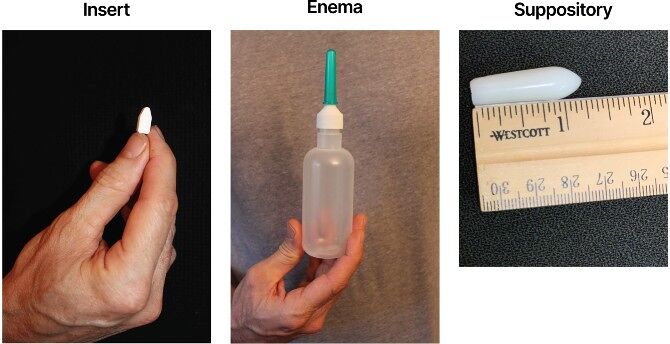
Researchers continue to look at ways to help protect people from acquiring HIV. Some recent studies have looked at methods to quickly get HIV-preventing drugs into your body when they’re most needed.
Although a daily tablet is the most common way of taking PrEP, not everyone wants to take a pill every day of their life. Also, in some parts of the world, including parts of the US, access to PrEP is not straightforward.
A recent clinical trial tested whether people would be happy to insert rectal microbicides—an experimental HIV-prevention strategy—inside their butt before anal sex.
Rectal microbicides are not PrEP drugs, but a different form of HIV-prevention medicine that works on anal and rectal tissue before sex. Until now, it’s very difficult to apply microbicidal gel far enough inside the rectum to provide good protection. That’s why researchers are exploring other routes of delivery.
They gave their test subjects three methods of anal insertion: Enemas, suppositories, and rectal inserts. From the images they included, there’s not a huge difference between a suppository and an insert besides size.
In each case, placebos were used. The study wanted to determine if people were happy with insertion methods. It was not looking at the effectiveness of the drugs.
Popular were PrEP is not easily available
The most popular form of insertion proved to be enemas and rectal inserts. Seventy percent of people tested used enemas and inserts regularly, and more than 75% rated them both highly. This edged ahead of suppositories.
The trial took place in Peru, South Africa, Thailand, Malawi, and the United States. Enemas proved widely popular, but popularity dipped slightly in some US cities, including San Francisco. The researchers speculate that this could be because PrEP is widely available in such locations, so participants might be less enthused about other HIV prevention methods.
The participants — mainly cisgender gay men aged 18-35 — were evaluated after four weeks. They reported an average number of five receptive anal sex encounters, with three different men, during that period.
The number of people who said they used one of the methods on all occasions was: 83% for the enema, 75% for the rectal insert, and 74% for the suppository.
The authors say, “Our trial addresses the limited data available regarding the safety and acceptability of and adherence to enemas, inserts, and suppositories as potential modalities through which to deliver a rectal microbicide. Findings from this trial demonstrate high safety profiles, alongside high levels of acceptability and adherence, among all three.”
Further research is now needed to prove that rectal microbicides work effectively when delivered by these methods.
Rectal PrEP
Besides a daily PrEP pill, a long-acting injectable form of PrEP is also available in the US.
PrEP is also known to be highly effective if taken before and after sex (usually, two pills taken 2-24 hours before sex and then another pill 24 hours after the first dose and then again after another 24 hours). This 2-1-1 method is known as “on-demand” or ” event-driven” PrEP. The FDA has not approved this method in the US but it’s known that some guys use PrEP this way.
Researchers continue to look for other ways to administer the drug.
A group of researchers at the Contraceptive Research and Development (CONRAD) program have explored whether a quickly-dissolving PrEP pill that is inserted into the rectum or vagina also works.
Dr. Sharon A. Riddler, a professor of infectious diseases at the University of Pittsburgh School of Medicine, shared the results of a study earlier this year at the Conference on Retroviruses and Opportunistic Infection in Seattle in February.
Anal inserts offer protection in nonhuman primates. This led Riddler and her team to studying 23 people, mainly men.
The participants took a PrEP insert. Afterward, blood, rectal fluid, and rectal tissue were collected. This was to check if the drug had entered their tissue and bloodstream. Researchers repeated the process seven weeks later, but with two inserts.
“Safe, discreet, on-demand”
The test showed positive drug uptake. However, two inserts worked better than one. The higher dosage increased the risk of mild side effects (mild anal inflammation or rash) in one participants. However, this was not extreme enough to dissuade the researchers. They believe rectal PrEP is worth investigating further.
“Although the currently available products for prevention (oral, injectable, ring) have all been proven to be effective, there remain many barriers to these being used by people with the greatest need for prevention,” said Riddler.
“Additionally, even people who can access PrEP often do not because of cost, side effects, inconvenience, etc., so the continued development of a safe, discreet, on-demand, flexible option would be a great outcome of this small Phase 1 clinical trial.”
In short, if you only want to take HIV protection when you know you’re bottoming, more specific methods to do so could be on the horizon.





















Pietro D
Well bring them on………… I’m never a bottom, in any case, so I could care less.!
305Ghuy
NEWSFLASH macho man: while it’s not as easy, there are ‘Kinsey 0′ guys out there that have experienced female to male HIV transmission. Anal tissues are more permeable in both directions. Just sayin’.
Openminded
I’m thinking a lube with the microbicide med added would be a great way to introduce the medicine, assuming the body could absorb the meds from within the lube. Maybe a small “sounding type” med for the top to use before coitus. This would guarantee the meds go as deep as the seed. Then again, probably want to ensure meds are applied BEFORE the sperm goes spewing. Although I’m a huge proponent for the daily pill being a life saver and therefore people should be willing to diligently stick to the regiment, it is good that research is looking at alternative methods to deliver protection.
Openminded
Now that I’ve slept on it, the lube idea probably isn’t a good option for those who do oral only. LOL
305Ghuy
Replying to your query on the quarterly testing for someone on pill-PrEP… on it for 6yrs now; like any medication their are no 100% guarantees of affectiveness (thinik condom use, The Pill to stop pregnancy). We are dealing with a virus that has mutated and morphed and built resistance to the bombs we’ve lobbed at it for 40+ yrs. PrEP is a combination of early HIV meds used for those folks already affected so they want to monitor you.
The medication is also liver metabolized so they are monitoring how your body is processing the drugs. If you are on additional medications that is really important. Yes, if you are sexually active enough to request PrEP meds; and recognizing NOBODY is 100% perfect with condom usage (which while on PrEP you should still be using against other STI) your doctor/care provider is also monitoring for any other potential infections.
nm4047
code for foreplay?
JanDivine
As an HIV RN I have long wondered why we could not come up with a lube that stops the virus. Maybe we are getting close.
quantum
I actually did a research study on HIV-preventative lube. Using an applicator that looked like the ones for tampons, you put it up your butt daily or right before anal sex.
Openminded
Question for you med guys. Prep requires quarterly STD/HIV testing to ensure no infections are present. Is Prep dangerous for an HIV+ patient to take or is this simply a tacked on requirement that allows the system to force additional testing in hopes of, I assume, slowing the spread of STD’s. I’m not necessarily against mandated testing, but on the flip side, I’m against misrepresenting the truth about the actually medical necessity of these tests if that is the case. The general public already distrusts much that the medical authorities say and almost all of what politicians say, so I think it is very important to be honest and upfront with the reasons for any “requirements”. Covid should have taught us that. Well intentioned precautions and statements were turned into alleged intentional infringements of our rights.
1898
“Also, in some parts of the US, access to PrEP is not straightforward.”
if you’re living in a place where it’s difficult or impossible to get generic truvada, it’s hard to imagine that you’ll have an easier time getting HIV-preventive suppositories or enemas. generic truvada has been available in the US for three years, and there are tons of programs that make it available at very low cost or for free. any doctor or nurse practitioner can prescribe it, and any pharmacy can order it.
if discretion is an issue, i would think it would be easier to be discreet with a plain white pill than with an enema
regardless of which method you choose, you’re still going to need bloodwork done every three months. seems like that would be a much bigger hurdle for folks in rural / poor / anti-gay areas than the question of pill vs. suppository vs. enema
radiooutmike
I think this is great. Any way you can increase use of PrEP is fine by me.
My questions would be: Would you need a doctor’s prescription or would it OTC? And, how much would it cost?
305Ghuy
After I stopped chuckling, realizing the article was serious, I thought… whatever gets the job done. I appreciate the fact the article speaks frankly about sexually active gay men engaging in anal sex; the primary route of transmission.
I’ve been a ‘PrEPper’ for… 6yrs. I found a gay doctor so I could be frank about the care I wanted to receive, without fear, shame or judgment. I have other daily meds and vitamins I take every morning already so another pill to swallow isn’t a problem. For prevention before PrEP, if you thought you might get ‘laid’ after a night out with your boys you would grab a couple of condoms, slipping a waxy tick-tack up your bum would be just as easy. Definitely a novel approach. Hopefully it will be cheaper that PrEP pills.